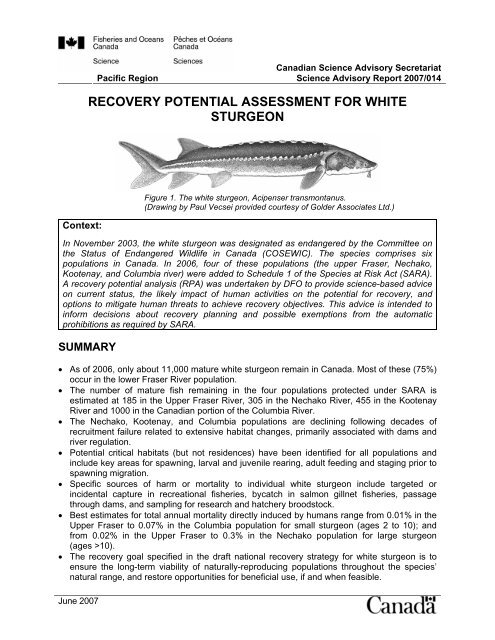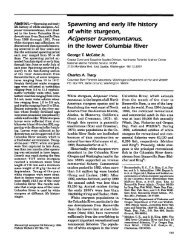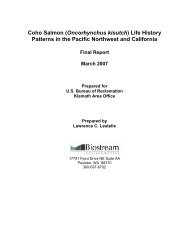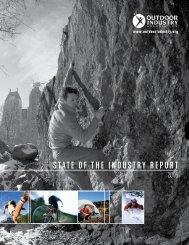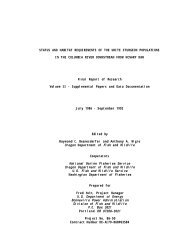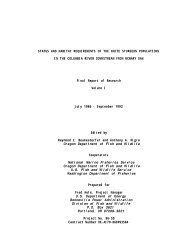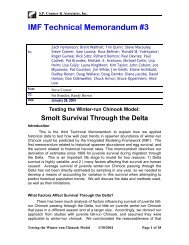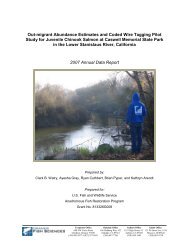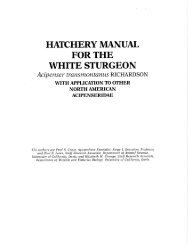RECOVERY POTENTIAL ASSESSMENT FOR WHITE STURGEON
RECOVERY POTENTIAL ASSESSMENT FOR WHITE STURGEON
RECOVERY POTENTIAL ASSESSMENT FOR WHITE STURGEON
Create successful ePaper yourself
Turn your PDF publications into a flip-book with our unique Google optimized e-Paper software.
Context:<br />
June 2007<br />
Pacific Region<br />
Canadian Science Advisory Secretariat<br />
Science Advisory Report 2007/014<br />
<strong>RECOVERY</strong> <strong>POTENTIAL</strong> <strong>ASSESSMENT</strong> <strong>FOR</strong> <strong>WHITE</strong><br />
<strong>STURGEON</strong><br />
Figure 1. The white sturgeon, Acipenser transmontanus.<br />
(Drawing by Paul Vecsei provided courtesy of Golder Associates Ltd.)<br />
In November 2003, the white sturgeon was designated as endangered by the Committee on<br />
the Status of Endangered Wildlife in Canada (COSEWIC). The species comprises six<br />
populations in Canada. In 2006, four of these populations (the upper Fraser, Nechako,<br />
Kootenay, and Columbia river) were added to Schedule 1 of the Species at Risk Act (SARA).<br />
A recovery potential analysis (RPA) was undertaken by DFO to provide science-based advice<br />
on current status, the likely impact of human activities on the potential for recovery, and<br />
options to mitigate human threats to achieve recovery objectives. This advice is intended to<br />
inform decisions about recovery planning and possible exemptions from the automatic<br />
prohibitions as required by SARA.<br />
SUMMARY<br />
• As of 2006, only about 11,000 mature white sturgeon remain in Canada. Most of these (75%)<br />
occur in the lower Fraser River population.<br />
• The number of mature fish remaining in the four populations protected under SARA is<br />
estimated at 185 in the Upper Fraser River, 305 in the Nechako River, 455 in the Kootenay<br />
River and 1000 in the Canadian portion of the Columbia River.<br />
• The Nechako, Kootenay, and Columbia populations are declining following decades of<br />
recruitment failure related to extensive habitat changes, primarily associated with dams and<br />
river regulation.<br />
• Potential critical habitats (but not residences) have been identified for all populations and<br />
include key areas for spawning, larval and juvenile rearing, adult feeding and staging prior to<br />
spawning migration.<br />
• Specific sources of harm or mortality to individual white sturgeon include targeted or<br />
incidental capture in recreational fisheries, bycatch in salmon gillnet fisheries, passage<br />
through dams, and sampling for research and hatchery broodstock.<br />
• Best estimates for total annual mortality directly induced by humans range from 0.01% in the<br />
Upper Fraser to 0.07% in the Columbia population for small sturgeon (ages 2 to 10); and<br />
from 0.02% in the Upper Fraser to 0.3% in the Nechako population for large sturgeon<br />
(ages >10).<br />
• The recovery goal specified in the draft national recovery strategy for white sturgeon is to<br />
ensure the long-term viability of naturally-reproducing populations throughout the species’<br />
natural range, and restore opportunities for beneficial use, if and when feasible.
Pacific Region RPA – White Sturgeon<br />
• Specified quantitative recovery objectives that could be assessed in simulation scenarios<br />
include (1) to ensure no net loss of reproductive potential, (2) to achieve within 50 years (a)<br />
1000 mature individuals, (d) ongoing natural recruitment, and (e) population growth when<br />
below the abundance target [2(b) and 2(C) not addressed].<br />
• For the Upper Fraser population, simulation model projections suggest that all recovery<br />
objectives except 2a can be achieved if total human-induced mortality does not exceed twice<br />
the estimated status quo level. Simulation results based on assumptions about historic<br />
abundance raise doubts about the necessity of achieving 1000 mature fish (recovery<br />
objective 2a) and continued population growth (recovery objective 2e).<br />
• For the Nechako, Kootenay, and Columbia populations, simulation model projections indicate<br />
that:<br />
o extinction in the wild is inevitable, even in the absence of further human-induced<br />
mortality unless human intervention can restore natural recruitment.<br />
o natural recruitment must be restored almost fully to historic rates to achieve<br />
recovery objectives.<br />
o restoration of historic rates of natural recruitment would be sufficient to achieve<br />
abundance objectives within 100 years, but not within 50 years.<br />
o hatchery supplementation will also be necessary to achieve abundance<br />
objectives, but would not be sufficient by itself.<br />
• Scenarios with habitat restoration to fully restore historic rates of natural recruitment<br />
combined with low level, short-term hatchery releases, indicate that recovery objectives<br />
could likely be achieved in the face of continuing incidental mortality not exceeding twice<br />
the estimated current level in each of the three non-recruiting populations.<br />
Figure 2. Approximate ranges for the four white<br />
sturgeon populations in the Fraser River basin<br />
(from Wood et al. 2007).<br />
2<br />
Figure 3. Approximate ranges for the two<br />
white sturgeon populations in the Columbia<br />
River basin (from Wood et al. 2007).
Pacific Region RPA – White Sturgeon<br />
BACKGROUND<br />
The white sturgeon is the largest, longest-lived freshwater fish species in North America with a<br />
maximum length of over 6 m and maximum age of over 100 years (Figure 1). Females spawn<br />
for the first time at about 26 years of age, and spawn repeatedly but at intervals ranging from 4<br />
to 11 years. White sturgeon are broadcast spawners, releasing large numbers of eggs and<br />
sperm into the water column of turbulent river habitats. Spawning occurs in the late spring and<br />
early summer, typically following the highest water levels of freshet, as water temperatures are<br />
rising, in fast water velocities, over coarse substrates. This life history makes the white sturgeon<br />
extremely vulnerable to human activities in freshwater habitats.<br />
White sturgeon are found only in the mainstem and larger tributaries of three major drainages<br />
on the Pacific coast of North America: the Fraser, Columbia and Sacramento rivers. Six<br />
genetically distinct populations have been identified in Canada, all in British Columbia (Figures<br />
2 and 3). A catch-and-release fishery targets white sturgeon in the mid- and lower Fraser river<br />
populations. There is no directed fishing for white sturgeon in the other four populations.<br />
In 2003, COSEWIC designated the white sturgeon as endangered in Canada. In 2006, the four<br />
populations without directed fisheries (the upper Fraser River, Nechako River, Columbia River,<br />
and Kootenay River populations) were added to Schedule 1 of SARA. Designation under SARA<br />
has triggered a requirement for scientific assessment of current status, critical habitat, recovery<br />
objectives, the likely impact of human activities on the potential for recovery, and options to<br />
mitigate human threats to achieve recovery objectives. This detailed recovery potential<br />
assessment is provided by Wood et al. (2007).<br />
<strong>ASSESSMENT</strong><br />
Trends and Current Status<br />
The upper Fraser population in 2001 was estimated at 815 fish of 50 cm or larger based on a<br />
mark-recapture study (Yarmish and Toth 2002). No trend data are available. Abundance is<br />
believed to be naturally low in this region and to be within the historic range based on the<br />
apparent absence of significant threats both historically and currently, and evidence that age<br />
composition is as expected for a population at equilibrium.<br />
The Nechako population in 1999 was estimated at 571 fish (300 were likely mature) based on<br />
information from radio telemetry, recreational catch statistics, mark-recapture estimates and life<br />
history studies (RL&L 2000). Age composition is dominated by older individuals indicating that<br />
little or no juvenile recruitment has occurred since 1967. Applying an annual survival rate of<br />
92.3% (or M=0.08), the total population in 2006 is estimated at only 318 fish of which 286 are<br />
likely mature.<br />
The Kootenay population (including the transboundary reach from Libby Dam to Bonnington<br />
Falls) was estimated at 760 fish in 2000 based on radio telemetry, recreational catch statistics,<br />
mark-recapture estimates and life history studies (Paragamian et al. 2005). Age composition<br />
data indicate that natural recruitment began to decline in the mid-1960s and has been negligible<br />
since 1974. Thus, the (projected) natural population in 2006 is an ageing cohort of
Pacific Region RPA – White Sturgeon<br />
Keenleyside Dam to the border in 2003, and 2295 fish (95% CI was 1528-3574) downstream of<br />
the Canada-US border to the Grand Coulee Dam (including the Roosevelt Reservoir) (Golder<br />
2005). Age composition indicates that natural recruitment began to decline in 1969, and has<br />
failed almost entirely since 1985, so that the remaining natural population is at least 90%<br />
mature fish. Assuming an annual survival rate of 97%, abundance in 2006 is estimated at 3000<br />
mature fish, of which 1000 are in Canadian habitat.<br />
Natural populations in the Nechako, Kootenay, and Columbia rivers are declining as a result of<br />
recruitment failure related to extensive changes in habitat, many of which are associated with<br />
dams and river regulation (McAdam et al. 2005). Conservation aquaculture programs have<br />
been initiated to prevent extinction of these populations, beginning in 1990 for the Kootenay<br />
population, 2001 for the Columbia population, and 2006 for the Nechako population.<br />
Critical habitat and threats<br />
Potential critical habitats (but not residences) have been identified for all populations and<br />
include key areas for spawning, larval and juvenile rearing, adult feeding and staging prior to<br />
spawning migration (Appendix 1 of Wood et al. 2007). Threats to habitat include river regulation;<br />
instream activities such as dredging for gravel or sand; linear development; alterations or<br />
development of riparian, foreshore, or floodplain areas; upstream use of land and water; and<br />
effluent discharge from both point and non-point sources.<br />
Specific sources of harm or mortality to individual white sturgeon include targeted or incidental<br />
capture in recreational fisheries, bycatch in salmon gillnet fisheries, passage through dams, and<br />
sampling for research and hatchery broodstock. Best estimates for total annual mortality directly<br />
induced by humans range from 0.01% in the Upper Fraser to 0.07% in the Columbia population<br />
for small sturgeon (ages 2 to 10); and from 0.02% in the Upper Fraser to 0.3% in the Nechako<br />
population for large sturgeon (ages >10).<br />
Recovery objectives<br />
The recovery goal specified in the draft National Recovery Strategy for white sturgeon is to<br />
ensure the long-term viability of naturally-reproducing populations throughout the species’<br />
natural range, and restore opportunities for beneficial use, if and when feasible. Specified<br />
quantitative recovery objectives include (1) to ensure no net loss of reproductive potential, (2) to<br />
achieve within 50 years (a) 1000 mature individuals, (b) approximately 1:1 sex ratio at maturity,<br />
(c) distribution over the natural range, (d) ongoing natural recruitment, and (e) population growth<br />
when below the abundance target.<br />
Performance measures and simulations<br />
Recovery potential was assessed in Monte Carlo simulations with an age-structured, stochastic<br />
population model (details in Appendix 2 of Wood et al. 2007). Recovery objectives were reexpressed<br />
as numerical or probabilistic performance measures to evaluate recovery success<br />
under various scenarios. Feasibility of achieving recovery objective 1 (no loss of reproductive<br />
potential) was evaluated by keeping track of both the number of mature fish and the total<br />
potential egg deposition. The latter index takes into account that older fish are larger and can<br />
produce more eggs.<br />
4
Pacific Region RPA – White Sturgeon<br />
Recovery objective 2a was evaluated by computing the proportion of Monte Carlo simulation<br />
trials in which mature abundance exceeded 1000 in simulation year 50. The minimum number<br />
of spawners over the course of each simulation period was also recorded to monitor the risk of<br />
genetic bottlenecks and the expected availability of broodstock for hatchery supplementation.<br />
Recovery objectives 2b (equal sex ratio) and 2c (distribution over the natural range) were not<br />
evaluated. Instead, demographic stochasticity was introduced explicitly in computing the<br />
number of fish older than age 1 that survived each year, and an equal sex ratio was assumed.<br />
For scenarios that allowed natural recruitment, recovery objective 2d (continuing natural<br />
recruitment) was typically achieved whenever mature fish remained in the simulated population;<br />
this is because natural recruitment to age 1 in each year was computed with a stock-recruitment<br />
function based on potential egg deposition, subject to environmental stochasticity. However,<br />
status quo scenarios for populations that lack natural recruitment were simulated by adjusting a<br />
natural recruitment scaling parameter designed to model habitat suitability.<br />
Feasibility of achieving recovery objective 2e was evaluated by computing population growth<br />
rate based on population size at the beginning and end of each simulation trial, and then<br />
averaging over all trials. For hatchery supplementation scenarios, the proportion of mature fish<br />
that originated from natural spawning was computed at the end of each trial.<br />
Feasibility of achieving recovery objective 3 was not evaluated because targets for beneficial<br />
use have not been discussed by the national recovery team. However, the performance<br />
statistics were also computed in simulation year 100 to provide a longer term perspective. For<br />
most populations, recovery objective 2a could be achieved only within this longer time frame.<br />
Sources of uncertainty<br />
To determine whether simulated outcomes were particularly sensitive to uncertainty in the<br />
parameter values used in the population model, key parameters were systematically<br />
manipulated one at a time. This sensitivity analysis suggested that conclusions were robust<br />
(i.e., performance measures within ± 30%) over a plausible range of parameter values and<br />
levels of annual variability.<br />
It should be noted that simulation scenarios were selected to demonstrate the necessary and<br />
sufficient conditions for achieving recovery objectives, not to determine the best options for<br />
recovery. Other scenarios involving different trade-offs might achieve recovery objectives with<br />
better socio-economic outcomes.<br />
CONCLUSIONS AND ADVICE<br />
For the Upper Fraser population, simulation model projections suggest that all recovery<br />
objectives except 2a can be achieved if total human-induced mortality does not exceed twice<br />
the estimated status quo level. Simulation results based on assumptions about historic<br />
abundance raise doubts about the necessity of achieving 1000 mature fish (recovery objective<br />
2a) and continued population growth (recovery objective 2e). An alternative approach is to<br />
recognize that the naturally small size of the Upper Fraser population makes it inherently<br />
vulnerable to extinction, and to seek to maintain its current viability by preventing further<br />
deleterious impacts. Concerns about the potential loss of genetic diversity over the longer term<br />
that motivate recovery objective 2a might be addressed by intervention to manage gene flow<br />
with other populations.<br />
5
Pacific Region RPA – White Sturgeon<br />
For the Nechako, Kootenay, and Columbia populations, simulation model projections indicate<br />
that unless human intervention can restore natural recruitment, extinction in the wild is<br />
inevitable, even in the absence of further human-induced mortality. The simulation results<br />
indicate first, that (almost full) restoration of the historic rates of natural recruitment will be<br />
necessary to achieve recovery objectives, and second, that restoration of historic rates of<br />
natural recruitment would be sufficient to achieve abundance objectives within 100 years, but<br />
not within 50 years. Hatchery supplementation will also be necessary to achieve abundance<br />
objectives, but would not be sufficient by itself. Hatchery supplementation should be viewed as<br />
experimental, but supported as a calculated risk to reduce the serious risk of genetic<br />
bottlenecks in natural spawning expected over the next 30 years.<br />
Recovery potential for the three declining populations depends entirely upon successful human<br />
interventions to increase natural recruitment. Given a commitment to engage in habitat<br />
restoration that is deemed sufficient to increase natural recruitment to historic levels, and to<br />
hatchery supplementation that is deemed sufficient to avoid future genetic bottlenecks, some<br />
level of continuing incidental harm might be exempted without jeopardizing the survival or<br />
recovery of these populations. Simulated scenarios with habitat restoration to fully restore<br />
historic rates of natural recruitment combined with low level, short-term hatchery releases,<br />
indicate that recovery objectives could likely be achieved in the face of continuing incidental<br />
mortality not exceeding twice the estimated current level in each of the three non-recruiting<br />
populations.<br />
SOURCES OF IN<strong>FOR</strong>MATION<br />
Golder Associates Ltd. 2005. Upper Columbia River: white sturgeon population dynamics and<br />
analysis. Report prepared for Upper Columbia River White Sturgeon Recovery Initiative,<br />
Castlegar, B.C.<br />
McAdam, S.O., C.J. Walters, and C. Nistor. 2005. Linkages between white sturgeon (Acipenser<br />
transmontanus) recruitment and altered bed substrates in the Nechako River, Canada.<br />
Trans. Am. Fish. Soc. 134:1448–1456.<br />
Paragamian, V.L., R.C.P. Beamesderfer and S.C. Ireland. 2005. Status, population dynamics,<br />
and future prospects of the endangered Kootenai River white sturgeon population with<br />
and without hatchery intervention. Transactions of the American Fisheries Society 134:<br />
518–532.<br />
RL&L Environmental Services Ltd. 2000. Fraser River White Sturgeon Monitoring Program -<br />
Comprehensive Report (1995 to 1999). Final Report Prepared for BC Fisheries. RL&L<br />
Report No. 815F: 92 p + app.<br />
Wood, C.C., D. Sneep, S. McAdam, J. Korman, and T. Hatfield. 2007. Recovery potential<br />
assessment for white sturgeon populations listed under the Species at Risk Act. DFO<br />
Can. Sci. Advis. Sec. Res. Doc. 2007/003.<br />
Yarmish, J.A. and B.M. Toth. 2002. 2001/2002 Assessment of upper Fraser River white<br />
sturgeon. Report Produced by Lheidli T’enneh First Nation for Upper Fraser River<br />
Nechako Fisheries Council and Fisheries Renewal BC. 37 p.<br />
6
Pacific Region RPA – White Sturgeon<br />
<strong>FOR</strong> MORE IN<strong>FOR</strong>MATION<br />
Contact: Dr. Chris C. Wood<br />
Fisheries and Oceans Canada<br />
Conservation Biology Section<br />
Pacific Biological Station<br />
Nanaimo, British Columbia<br />
Tel:<br />
Fax:<br />
E-Mail:<br />
(250) 756-7140<br />
(250) 756-7053<br />
woodc@pac.dfo-mpo.gc.ca<br />
This report is available from the:<br />
Centre for Science Advice (CSA)<br />
Pacific Region<br />
Fisheries and Oceans Canada<br />
Pacific Biological Station<br />
3190 Hammond Bay Road<br />
Nanaimo, British Columbia<br />
V9T 6N7<br />
Telephone: (250) 756-7208<br />
Fax: (250) 756-7209<br />
E-Mail: psarc@pac.dfo-mpo.gc.ca<br />
Internet address: www.dfo-mpo.gc.ca/csas<br />
ISSN 1480-4913 (Printed)<br />
© Her Majesty the Queen in Right of Canada, 2007<br />
La version française est disponible à l’adresse ci-dessus.<br />
CORRECT CITATION <strong>FOR</strong> THIS PUBLICATION<br />
DFO, 2007. Recovery potential assessment for white sturgeon. DFO Can. Sci. Advis. Sec. Sci.<br />
Advis. Rep. 2007/014.<br />
7


